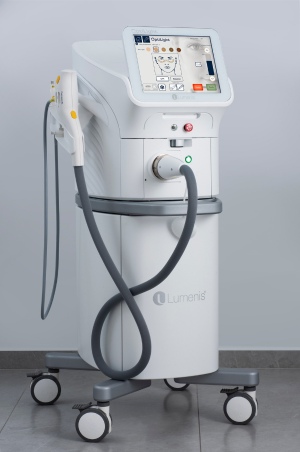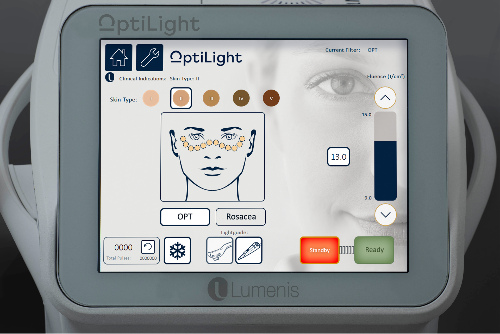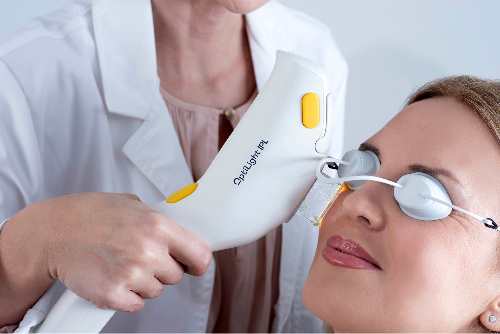 Drs. Ryan and Amber Fritsch are pleased to offer our patients OptiLight: the first and only light therapy FDA-approved for dry eye management!
Drs. Ryan and Amber Fritsch are pleased to offer our patients OptiLight: the first and only light therapy FDA-approved for dry eye management!
What is dry eye disease?
Dry eye disease is an inflammatory condition that can cause uncomfortable eyes, and even some vision problems. There are multiple causes of dry eye disease, including certain medications, environmental factors such as windy conditions and even extended screen time. Dry eye disease can be aqueous-deficient (meaning loss of the water part of our tear film), evaporative/lipid-deficient (meaning lack of good quality oil in our tear film), or a combination of the two. Evaporative is by far the most common.
We have 20-30 oil glands in our eyelids that are responsible for making the oil(lipid) part of our tear film. When those are not functioning properly and making good quality oil, our tears evaporate very quickly. This can cause burning, stinging, a gritty or foreign body sensation, and even excessive tearing. Inflammation can play a big role in the health and function of these glands. If they become unhealthy, their structure and function can be lost, and once they are lost, they cannot be recovered.
How is dry eye disease treated?
There are many ways we address dry eye disease treatment. Most commonly people use artificial tears, however these need to be used at least four times a day to gain benefit. Warm compresses and eyelid scrubs can also help, in addition to proper nutrition or supplementation with good quality omega 3 and omega 6 fatty acids.
There are prescription options for dry eye as well, including Restasis, Xiidra, and Cequa- all prescription drops that are used twice daily to help you make more of your own tears and better-quality tears. Tyrvaya is an additional option- it is a nasal spray that activates a nerve tied to the lacrimal gland and tear production.
There are in office treatments as well including BlephEx, which is a deep clean of the eyelids and oil gland openings, and OptiLight, which we will discuss in further detail.
Why OptiLight?
 OptiLight uses precise, intense light to address inflammation-an underlying cause of dry eye disease. It safely and effectively targets the oil glands in the eyelids and the surrounding tissues. Numerous clinical studies prove OptiLight is a safe and efficient way to improve signs of evaporative dry eye disease. Because it treats the root cause of dry eye disease, the need for artificial tears, lid scrubs, warm compresses, and even prescription medications is significantly reduced.
OptiLight uses precise, intense light to address inflammation-an underlying cause of dry eye disease. It safely and effectively targets the oil glands in the eyelids and the surrounding tissues. Numerous clinical studies prove OptiLight is a safe and efficient way to improve signs of evaporative dry eye disease. Because it treats the root cause of dry eye disease, the need for artificial tears, lid scrubs, warm compresses, and even prescription medications is significantly reduced.
What can I expect with OptiLight?
 Typical treatments include 4-6 sessions spaced 2-4 weeks apart. Each session takes about 20-30 minutes and can be done over lunch. Typically some improvement is noted after the first two sessions with increasing relief after the following treatments.
Typical treatments include 4-6 sessions spaced 2-4 weeks apart. Each session takes about 20-30 minutes and can be done over lunch. Typically some improvement is noted after the first two sessions with increasing relief after the following treatments.
For the treatment itself, a cooling gel is applied to the treatment area and eye protection is applied. There is a warm sensation as the light is applied to the skin. The treatment is gentle with minimal discomfort. For those who elect to have a full face treatment in addition to OptiLight (to reduce imflammation from conditions such as rosacea, or age spots and fine lines), the sensation is a slightly more intense and can feel like a warm rubber band snap.
Following treatment you may experience some redness, which usually disappears within a few hours. You can return to daily activities and even reapply makeup right away in most cases.
You should stay out of direct sunlight for a few days following treatment (and leading up to treatment), and apply sunscreen.
Please contact our office for additional information or with any questions.


